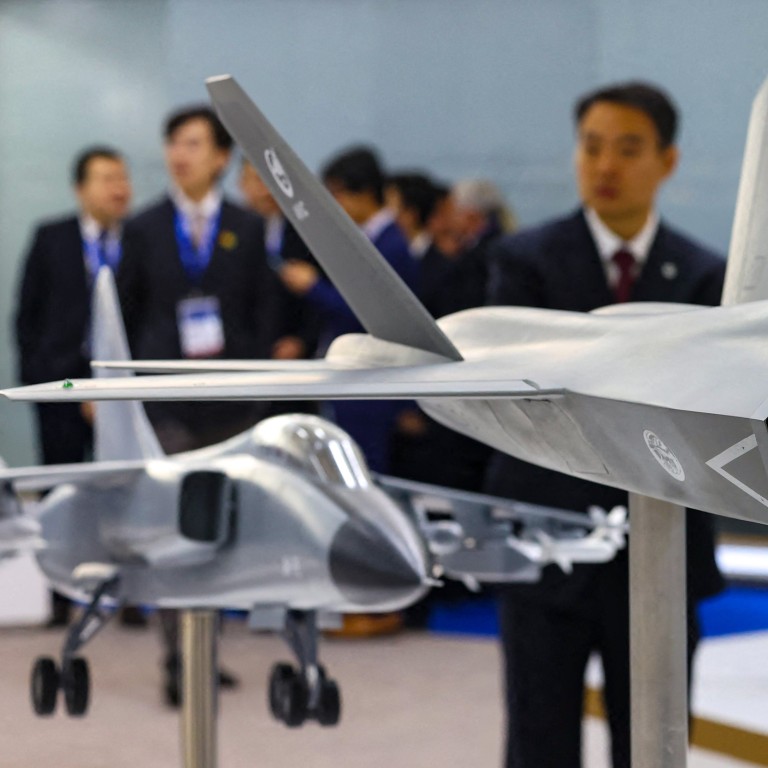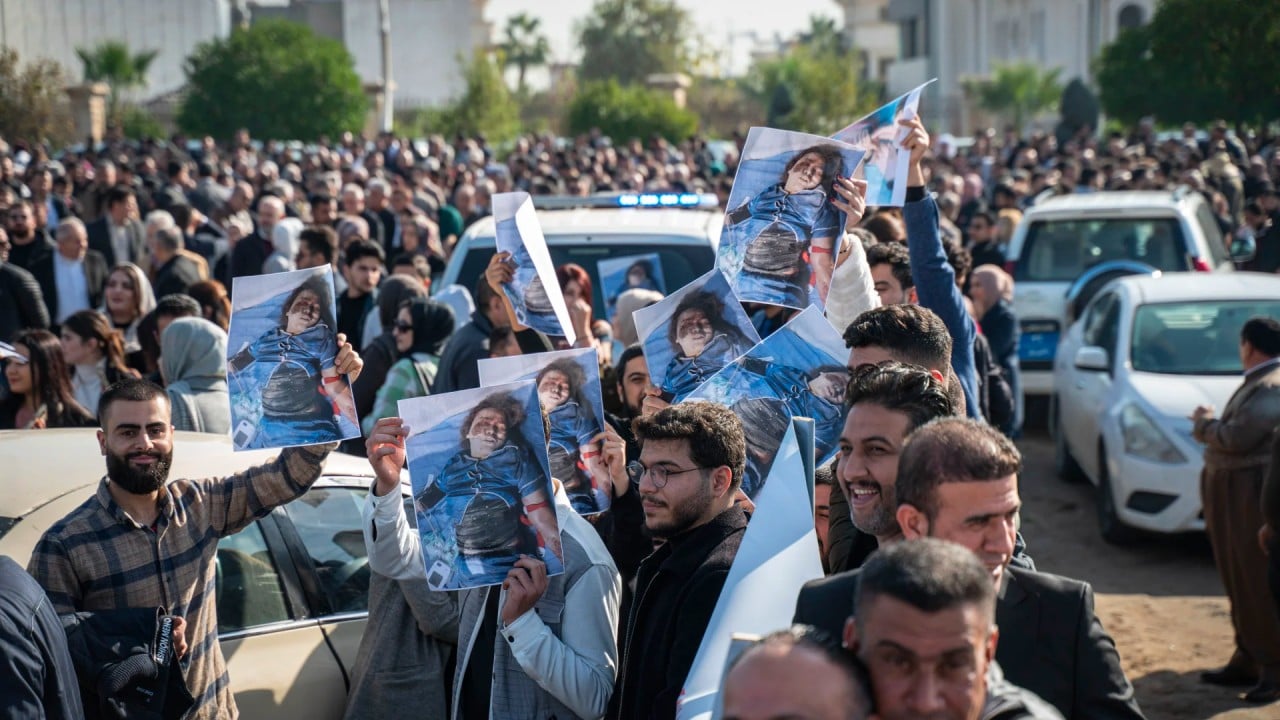
China displays FC-31 fighter model at Saudi defence show in bid to increase exports as Middle East nations explore options
- The threat of a wider conflict could encourage nations in the region to expand their fighter jet forces but China has challenges in eroding US dominance
- ‘Arms sales could build client relations between Middle East countries and China, which could pay off with lucrative deals in petroleum exports’: analyst
The jet is designed for use on aircraft carriers and is still in the development phase but its makers see it as a potential rival to fifth-generation US jets, the aircraft of choice for many countries in the region.
The threat of a wider regional conflict could encourage Middle Eastern countries to expand their fighter jet forces but according to observers, China will face big challenges in its bid to chip away at US dominance and fierce competition from other contenders.
While the F-35 has a lower maximum speed than the FC-31 – at 1.6 Mach versus 1.8 Mach – it is considered to have a longer combat range of 1,240km (770 miles) compared with the Chinese jet’s 1,207km (750 miles).
The display of China’s latest aircraft at the World Defence Show coincides with Middle Eastern countries seeking to expand their air-force capabilities in the face of growing regional conflicts in the Gaza Strip and the Red Sea.
At Riyadh’s Ministry of Defence pavilion, a military official said the Saudi Arabian military was most interested in strengthening air force and air-defence capabilities.
“We would like to raise cooperation with other countries to [strengthen these areas],” the official said.
Timothy Heath, a senior international defence researcher at the US-based think tank Rand Corporation explained why fighter jets drew buyers’ attention.
“With Iran and its proxies increasingly willing to use force, and Sunni countries eager to constrain Iran, there are strong incentives in many countries to build up their militaries,” Heath said.
“Air forces are particularly attractive because they can serve a variety of roles, including air-to-ground support, air-to-air combat, reconnaissance and anti-ship strikes. They can also reach long distances very rapidly and travel over both land and water.”
The Middle East maintains strong ties with US arms contractors, and both Lockheed Martin and Boeing had a noticeable presence at the defence show. According to the latest report from a Swedish think tank, Stockholm International Peace Research Institute (SIPRI), some 41 per cent of US arms exports went to the Middle East between 2018 and 2022.
During Donald Trump’s presidency, the United Arab Emirates reached a deal with the US to buy 50 F-35s in return for establishing diplomatic ties with Israel, the only Middle Eastern country with the fighter in operation.
However, the deal was halted after US President Joe Biden came to power in 2021 because of the UAE’s relationship with China and the possibility that technological secrets would be leaked.
Kostas Tigkos, head of mission systems and intelligence at global military intelligence company Janes, said that as US export restrictions raised the bar for buying the F-35, Middle Eastern countries sought other arms exporters, including China, to sell fighter jets in the region.
China eyes ‘big demand’ for armed drones in Middle East amid conflicts in region
“From a market perspective, [Chinese fighter jets] will compete against not only F-35 but also Russian Sukhois and even Turkish KAAN. Especially against the F-35, it will allow access to a modern fifth-generation platform for nations that otherwise would not be able to either afford, or be allowed, to import the F-35,” Tigkos said.
“Most countries in the Middle East operate fourth-generation fleets and need to quickly transition to fifth-generation platforms to stay current and improve survivability of their aircraft against modern and integrated air defences.”
The Catic official at the defence show in Riyadh also declined to provide any further details about the FC-31 deal with Pakistan.
Tigkos said China had an edge in price and export restrictions because of Washington’s delay in approving exports of the F-35 to the Middle East allowing “plenty of room for competition to step in and offer other designs”.

However he said introducing a Chinese or Russian stealth platform was likely to be “detrimental” for the importers because it was likely to sour relations with the US and prevent them from accessing other advanced equipment.
“Let’s consider [that] the major Middle East nations have all purchased advanced air defence and infrastructure from the US while also operating almost exclusively US fighters,” Tigkos said.
“If they buy Chinese, they risk a clash with the US, which could, in turn, result in perhaps sanctions. That would be very bad for their current equipment or modernisation plans.
“So China could, for example, target countries like Pakistan, and even Iraq [with less reliance on the US]. But others like UAE, Saudi and Egypt are too reliant on US equipment to break away and go for an advanced platform from an adversary nation, regardless of how cheap or capable it might be.
“Turkey, South Korea, and other perhaps European projects are much more viable and palatable,” he said.
Torbjorn Sjogren, Boeing’s vice-president and general manager of international government and defence, said Riyadh was interested in a “number of products in [the company’s] portfolio”, including F-15EX fighter jets.
The Saudi military reportedly operates more than 400 Boeing-built aircraft, including more than 200 fourth-generation F-15s in its air force.
South Korea is also an emerging arms contractor trying to increase its presence in the Middle East.
South Korean Defence Minister Shin Won-sik made the trip to Saudi Arabia for the defence show and signed a memorandum of understanding on long-term defence industry collaboration between the two countries.
An official from South Korean fighter jet engine manufacturer Hanwha Aerospace who declined to be named said there was potential in the region for his company’s product.
“There is demand in the Middle East, and they have mainly used fighter jets from Europe and the US. So, we are working … for exports in the region once the sixth generation [of fighter jets] is developed and put into service,” the official said.
“Saudi Arabia is very interested in this [sixth-generation fighter jets]. We intend to use this opportunity to jointly cooperate with Saudi Arabia to build fighter jets.”
South Korea lawmakers urge tougher laws after alleged theft of warplane secrets
Despite the competition and containment from the US and other potential competitors, Heath said China was likely to continue stepping up arms sales to the Middle East.
“It is the easiest and lowest risk way for China to protect its interests in the area. The danger, of course, is that a heavily militarised Middle East could result in a high level of instability and conflict, which could endanger Chinese interests,” he said.
“Another reason is that China seeks to build up its relations with all countries in the area, and arms sales are one way to do that. Arms sales could build ‘client’ relations between Middle East countries and China, which could pay off with lucrative deals in petroleum exports to China.”



